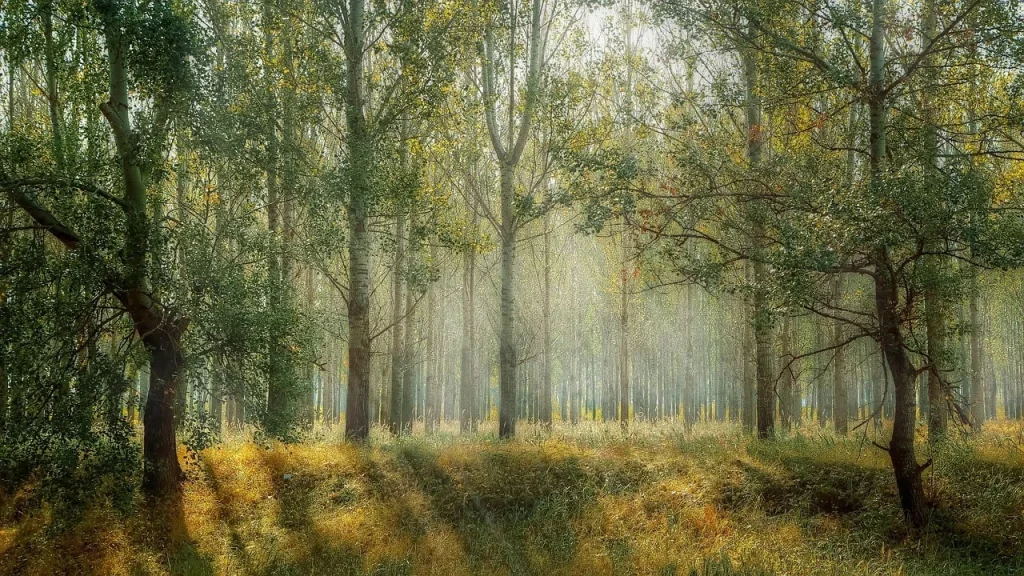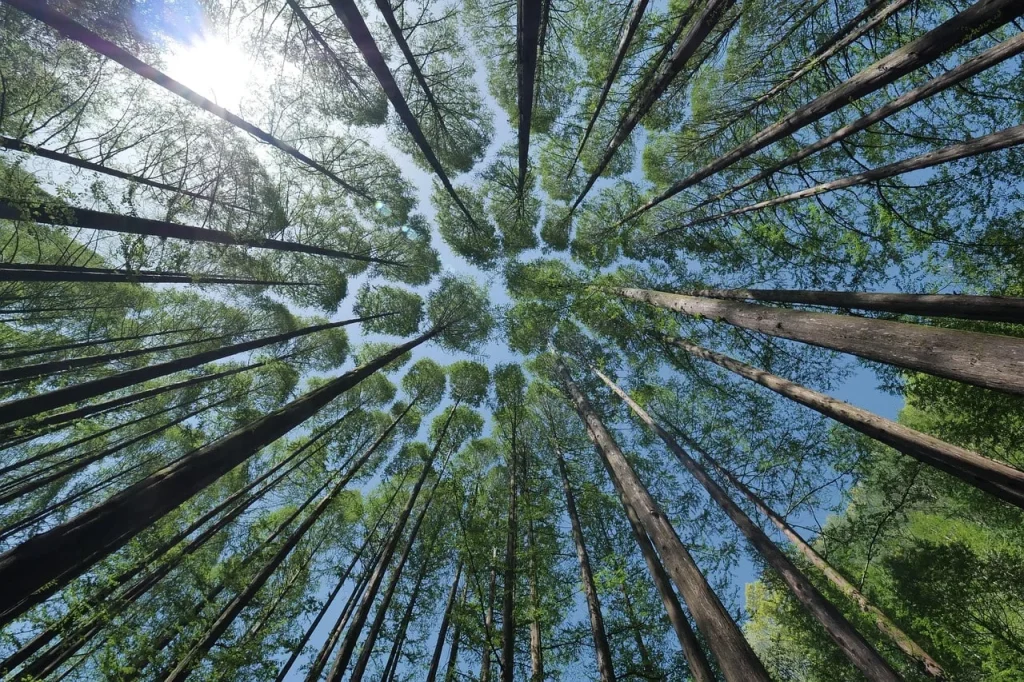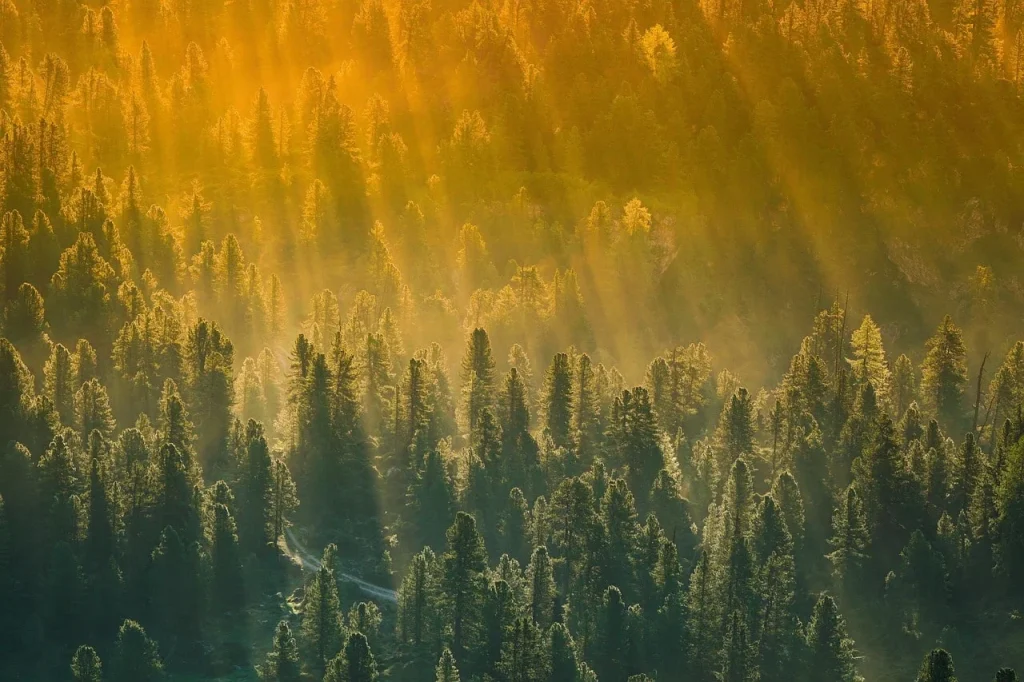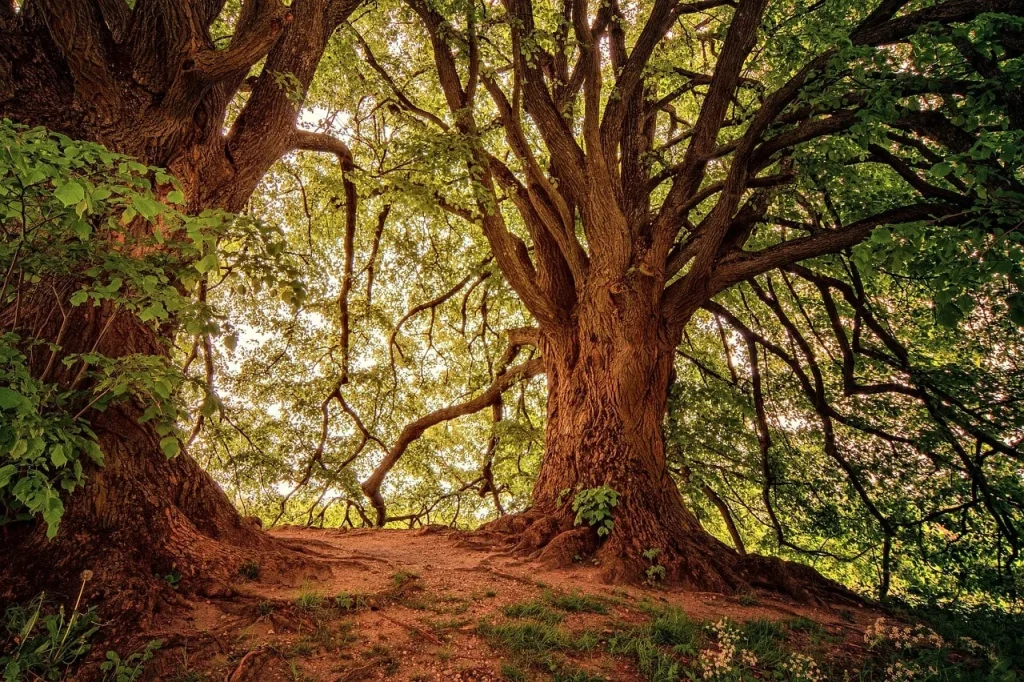Forests cover about 31% of the Earth’s land area, but they hold some of the most amazing secrets of our planet. Have you ever wondered what life is like beneath the dense canopy of a rainforest or how ancient trees survive through the ages?
Forests are not just a collection of trees; they are vibrant ecosystems teeming with life, offering shelter, food, and oxygen to countless species, including humans. Let’s explore some interesting facts about forests that will leave you in awe of these incredible natural wonders.
The clearest way into the Universe is through a forest wilderness.
John Muir
Forest Facts
Forests are incredible ecosystems teeming with life and mystery. Let’s jump into these fascinating facts and be sure to read carefully because there’s a quiz at the end to test your expertise!
- Amazon rainforest produces 20% of the world’s oxygen.
- Shinrin-yoku, or forest bathing, reduces stress and improves mental health.
- There are more species of trees in a single hectare of the Amazon than in all of North America.
- Redwoods are the tallest trees, reaching over 350 feet in height.
- Temperate rainforests are rarer than tropical ones, found in only a few places like the Pacific Northwest.
- Forests cover 31% of the land area on our planet.
- Mangrove forests act as natural coastal defenses, reducing the impact of storm surges.
- One tree can absorb as much carbon in a year as a car produces driving 26,000 miles.
- Baobab trees can live for over a thousand years and store water in their trunks.
- Scientists have discovered that trees can communicate through a network of fungi in the soil.
- Old-growth forests store more carbon than any other ecosystem on Earth.
- More than 80% of terrestrial animals and plants live in forests.
- Some trees emit chemicals that attract predators of their pests.

- Woodlands in the UK have been shrinking for the past few centuries.
- Forests provide livelihoods for over 1.6 billion people.
- Planting trees can help combat urban heat islands.
- The Congo Basin is the second-largest tropical rainforest in the world.
- Bamboo, technically a grass, can grow up to 35 inches in a single day.
- Leaves from some trees contain chemicals that reduce water evaporation.
- Sequoias are not only tall but also incredibly massive in volume.
- Forests play a critical role in the water cycle, influencing rainfall patterns.
- More than 60% of the Amazon rainforest is in Brazil.
- Deforestation contributes more to global warming than the entire transport sector.
- Some trees produce seeds that only germinate after a fire.
- Urban forests can improve air quality and reduce energy costs for cooling.
- The Taiga, or boreal forest, is the world’s largest land biome.
- Forests can influence local climates by maintaining humidity levels.
- Logging and agriculture are the primary causes of forest loss.

- Some tree species can tolerate saltwater, thriving in coastal environments.
- Acacia trees in Africa can signal each other to produce toxins against herbivores.
- Mycorrhizal networks in the soil help trees share nutrients and water.
- Ancient trees can harbor unique ecosystems within their bark and branches.
- Trees in urban areas can increase property values by up to 15%.
- Forest floors can store up to 40% of the total carbon in a forest ecosystem.
- Each year, an area the size of New York City is lost to deforestation.
- Some forests have “ghost” trees that survived wildfires due to their thick bark.
- The Black Forest in Germany is famous for its dense woods and legends.
- Forest canopies provide a unique habitat for many species that never touch the ground.

- Carbon sequestration in forests helps mitigate climate change impacts.
- Jungle is a term specifically used for dense, tangled, and overgrown vegetation.
- Amazon rainforest is home to more than 400 billion individual trees.
- Forests have been home to some of the oldest human cultures on Earth.
- Tree rings can provide valuable climate data from thousands of years ago.
- Ancient forests existed even during the time of dinosaurs.
- Clear-cutting is the most destructive form of logging, removing entire ecosystems.
- Some trees can “warn” their neighbors about insect attacks through chemical signals.
- Root systems of trees can be as extensive as their canopy spread.
- Wetlands within forests play a crucial role in filtering water and preventing floods.
- Each second, an area of forest equivalent to a football field is lost.
- The Amazon is sometimes called the “Lungs of the Earth” for its vast oxygen production.
Forest Myths

Now that we’ve explored the facts, let’s tackle some common myths. It’s important to separate what’s true from what’s simply a tall tale.
- Trees are Always Beneficial to the Environment When Planted Anywhere
Trees, while generally beneficial, can be detrimental when planted in non-native ecosystems. Local flora and fauna can be negatively impacted, and water resources might be strained. - All Forest Fires are Harmful
It is often believed that all forest fires are destructive, yet many ecosystems rely on periodic fires for regeneration. Nutrients are returned to the soil and unhealthy vegetation is naturally removed. - Older Forests Capture More Carbon Than Young Forests
Younger forests are observed to have a higher rate of carbon absorption due to their rapid growth. Older forests still play a critical role in carbon storage but do not sequester as much annually. - Cutting Down Trees is Always Bad for the Environment
Sustainable logging practices are in place that ensure forests regenerate and maintain their ecological functions. These practices include selective logging and replanting, which help preserve forest health. - Planting Any Type of Tree is Good for Biodiversity
The introduction of non-native tree species can be seen as beneficial for coverage, yet it can disrupt local ecosystems. Native species are always recommended as they support local wildlife and maintain ecological balance.
Forest Quotes

I hope you are enjoying the facts and myths so far because we continue to the quotes section. Feel free to share more in the comments so I can add them to the list.
The forest makes your heart gentle. You become one with it… No place for greed or anger there.
Pha Pachak
Pha Pachak, a revered Thai Buddhist monk, highlights the calming and transformative power of the forest, suggesting it fosters compassion and tranquility in the human spirit.
Forests are the lungs of our land, purifying the air and giving fresh strength to our people.
Franklin D. Roosevelt
Franklin D. Roosevelt, the 32nd President of the United States, emphasizes the critical ecological role of forests in purifying air and symbolically nourishing the spirit and strength of the people.
A forest bird never wants a cage.
Henrik Ibsen
Henrik Ibsen, a major 19th-century Norwegian playwright, poet, and theater director, uses this metaphor to underline the inherent value of freedom and the natural state of living beings, particularly in the context of the forest as a space of liberty.
In some mysterious way woods have never seemed to me to be static things. In physical terms, I move through them; yet in metaphysical ones, they seem to move through me.
John Fowles
John Fowles, an English novelist known for his philosophical depth, describes his experience in forests as dynamic and spiritually immersive, suggesting a mutual interplay between the woods and the self.
The forest is not merely an expression of beauty, but a symposium of the learning and the teaching of all things.
Frank Lloyd Wright
Frank Lloyd Wright, an American architect known for his philosophy of organic architecture, sees the forest as a living repository of knowledge, where every element has something to teach and learn.
Forest FAQ

Now that we’ve explored the depths of forest wisdom through quotes, let’s gear up for the quiz. Carefully review these frequently asked questions to ensure you’re fully prepared.
- Are forests a renewable resource?
Yes, they are considered a renewable resource because they can regenerate naturally and can be replanted. However, their renewal depends on responsible management and sustainable practices. - What is the primary function of a forest?
The primary function of forests is to provide habitat to diverse species of plants and animals. Additionally, forests play a crucial role in carbon sequestration, helping to mitigate climate change by absorbing carbon dioxide from the atmosphere. - How do forests contribute to the water cycle?
They contribute significantly to the water cycle through a process called transpiration, where water evaporates from the surface of leaves. This helps in cloud formation and increases precipitation, which is vital for water supply in many regions. - Why is biodiversity important in forests?
Biodiversity in forests is vital because it ensures ecosystem resilience and health. A diverse array of species can better withstand environmental stresses and maintain ecological functions, such as pollination, nutrient cycling, and pest control. - What are the effects of deforestation?
Deforestation can lead to a loss of habitat for millions of species, increased carbon emissions, disrupted water cycles, and soil erosion. It also impacts human communities, particularly those that rely on forests for their livelihoods and cultural practices.
Forest Trivia

Welcome to the Wild Woods Quiz! If you don’t get at least one question right, be prepared to become a tree’s new best friend – they’re always looking for someone to talk to about the weather.
Conclusion
We’ve seen how vital forests are to our planet, from regulating the climate to housing diverse wildlife. It’s our responsibility to ensure that these green giants are around for future generations to enjoy and benefit from.
Whether by planting new trees or supporting sustainable practices, every effort helps. Let’s keep our forests lush and thriving for a healthier world. Till next time, stay curious and explore more. Cheers.


